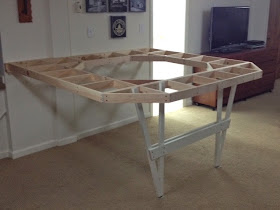Knowing that this was the closest I would ever get to one of these, I allowed myself a moment to fantasize. I had not applied for the prestigious award, but perhaps in our everybody-gets-a-trophy world, mine was a watered-down version based on the NMRA's overly optimistic interpretation of my potential... or maybe it was for this blog... Nah, I don't think so. And what about the inscribed name? Tough to make a case that it was just badly misspelled. "Boy, did spell-check do a number on this," I could say to visitors to my basement.
In truth, I am to present this to the newly elected president of the Garden State Division, Bruce DeYoung, at our board meeting this weekend. Bruce received recognition last month at our joint meet with the New Jersey Division along with their Tom Griffiths. Now the actual plaque is available.
 |
To paraphrase those well known television offers, the distinguished honor "is suitable for mounting." Plus, the number will be easy for Bruce to remember in his golden years!
|
Bruce is passionate about giving back to the hobby. He is not only an administrator of Railroad Line Forums, but is its most prodigious contributor. He is also Education Department Manager for the NMRA and a regular clinician at regional and divisional meets. The AP program and continued education for hobbyists is dear to 'Dutchman' and nicely dovetails with his expertise as a retired school superintendent and former math teacher.
His HO scale Jersey Highlands Railroad features the New York, Susquehanna & Western during the transition era. An area of the layout also depicts the HOn3 Slate Run Railroad, a logging operation in eastern Pennsylvania. But best of all, Bruce is one of the real good guys. Congratulations, buddy. You do the hobby proud. Wish we had more like you.
-30-
BONUS: RHETORICAL QUESTION OF THE DAY...
True or false? Bruce would be nothing without the love and support of his three sons, nine grandchildren and dear bride of 46 years, Bonnie.









































